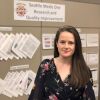Researchers in Chicago have published the study, “Identifying Key Words in 9-1-1 Calls for Stroke: A Mixed Methods Approach” in “Prehospital Emergency Care.” This study analyzed dispatch recordings of confirmed acute ischemic strokes to determine the words and phrases most commonly used by both the caller and the emergency medical dispatcher (EMD).
A total of 110 calls were listened to and transcribed. The median call lasted 61 seconds and averaged 89.3 words. Five percent of the calls came from locations with trained medical staff (e.g., clinics or nursing facilities).
Fifty-three of the calls (48 percent) were correctly recognized as stroke by the EMDs. These results align with prior research showing an EMD stroke recognition rate of 31-80 percent.
What makes this research unique compared to prior studies was the use of computational linguistics to analyze the language of the call. The word “stroke” was used by the caller in 81 percent of calls where stroke was recognized. In half of these cases, the caller explicitly stated “having a stroke,” while in another quarter of cases, the caller relayed a history of stroke.
Descriptive words typically associated with a stroke were also commonly used in recognized cases including:
Interestingly, callers used “think” in over half of the recognized cases, which the researchers point out is likely due to their uncertainty about the patient’s actual condition.
EMDs used many of the same words, but with a different distribution and a few protocol-based exceptions. The protocols in use at the time prompted the EMDs to ask if the patient was “awake” and “breathing normally.” As such, these were two of the most common EMD used phrases in cases of recognized stroke.
Other words frequently used by EMDs during recognized strokes included:
- “Down” (36 percent)
- “Side” (19 percent)
- “Sitting” (19 percent)
Memorable quotes about words associated with dispatcher-identified strokes
Here are four memorable quotes from the research article:
“Many callers used words and phrases suggestive of non-stroke emergencies, which may hinder EMD stroke recognition.”
“These findings suggest that, in order for EMDs to recognize stroke, caller descriptions of symptoms characteristic of stroke syndromes with preserved mental status (i.e., ‘slurred speech’ and ‘awake [and breathing]’) are critical.”
“Identifying patients with suspected stroke during a 9-1-1 call carries the potential to improve on-scene detection and the ‘downstream’ deployment of appropriate resources to the scene.”
“A novel extension of this work would be to implement algorithms into enhanced decision support tools for EMDs to detect words and phrases associated with a high probability of stroke.”
Key takeaways on the words associated with dispatcher-identified strokes
Here are the key takeaways for EMS leaders:
1. Community stroke education is critical
Less than 40 percent of callers used the word “stroke.” But, as could be expected, when it was used, recognition by the EMDs was nearly perfect. In the cases where vaguer language is used, recognition is significantly lower. Other studies have already proven that community education is an effective tool for increasing the public’s awareness of the signs and symptoms of a stroke.
2. Scientific demonstration of the barriers dispatchers face
In many communities, the rift between field personnel and dispatchers is well established. Each group faces unique challenges that the other is rarely able to appreciate. However, both play a crucial role in the identification and care of critically ill patients. This study quantifies many of the barriers EMDs face in a way that can be shared with non-dispatchers.
3. EMd protocols can serve a purpose
The dispatchers in this study used protocols that immediately questioned if the patient was awake and breathing. In the cases where the dispatcher used these words, and/or the caller used them, they were better able to recognize stroke. While the dispatchers don’t note the proportion of calls in which the protocols were followed, 51 percent of recognized cases used the term “awake.”














